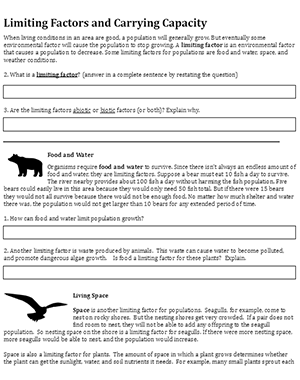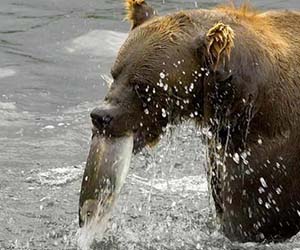
In this short exercise, students explore how limiting factors affect population growth. Students learn the definition of a limiting factor and apply it to several scenarios.
Limiting factors are environmental factors that can lower the population growth rate of a species. Density dependent factors increase as population size increase. These factors include available space, food, and other limiting resources.
Density independent factors are those that do not depend on the population size. They include things like weather phenomenon, natural disasters, or habitat destruction. They can also be related to independent factors. For example, if a hurricane reduces the amount of vegetation available, then the size of the population may decrease due to lack of food.
Scenarios for Students to Explore

In the first scenario, bears need a certain number of fish to survive. The number of bears in the area are limited by the number of fish in the river. Limiting factors also include waste produced by the bear which can pollute the river. These are density-dependent factors.
In the second scenario, seagulls are limited by nesting space. Plants are also limited by space where they need room to grow and be exposed to sunlight. This is another density-dependent factor.
In the third scenario, students explore how density-independent factors, like weather, and affect population size. A hurricane, or a cold front, can reduce populations, no matter how large the population is.
The final page shows a logistic growth curve with rabbits being limited by space and resources. Students label the graph showing where exponential growth occurred, overshoot, and population decline. Eventually the rabbit population stabilizes and remains at the carrying capacity.
Other Resources on Populations and Logistic Growth
- Google Slides (Chapter 5) – students can do this independently or in class
- Saving the Lynx – the story of rabbit overpopulation and the introduction of the lynx
- Predator Prey Simulation – simulation that explores limiting factors and predatation
- Can Sport Hunting Control Predators? – data analysis of cougar interactions with people
- Deer: Predation or Starvation – graph population size of deer; define zero population growth

